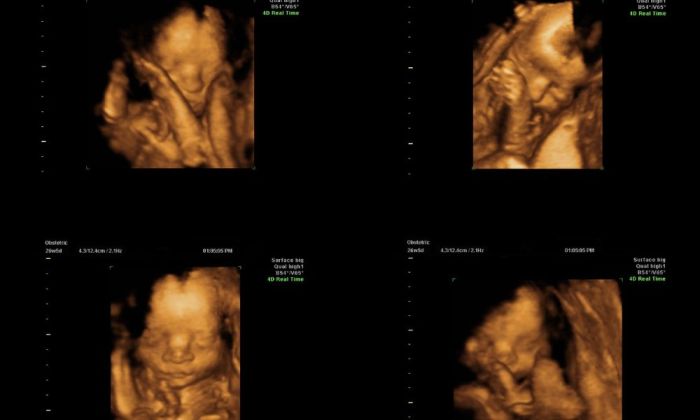The life-altering experience of expecting a child often comes with a flurry of decisions, including the choice of prenatal imaging. While a standard 2D ultrasound is typically covered by insurance, the captivating, detailed images offered by a 3D ultrasound often come with a significant out-of-pocket expense. This guide navigates the complexities of 3D ultrasound costs without insurance, offering a transparent look at pricing, influencing factors, and strategies for navigating the financial landscape.
From understanding regional price variations and package options to exploring payment plans and negotiating costs, we’ll equip you with the knowledge to make informed decisions about this increasingly popular imaging technology. We’ll also delve into alternatives and budgeting strategies to ensure you receive the prenatal care you need without undue financial strain.
Average Cost Range
The cost of a 3D ultrasound without insurance varies significantly across the United States, influenced by a complex interplay of geographical location, clinic type, and the specific services included. Understanding this variability is crucial for prospective patients seeking to budget for this procedure.
The following table presents a generalized average cost range based on publicly available data and industry reports. It’s important to note that these figures are estimates, and actual costs may deviate considerably. Always contact individual clinics for precise pricing.
Regional Cost Variations
| Region | Low-End Cost (USD) | High-End Cost (USD) | Average Cost (USD) |
|---|---|---|---|
| Northeast | 300 | 600 | 450 |
| South | 250 | 500 | 375 |
| Midwest | 200 | 450 | 325 |
| West | 350 | 700 | 525 |
Several factors contribute to the disparity in costs across regions. Higher costs in areas like the Northeast and West Coast are often attributed to higher operating costs, including rent and staffing salaries. Conversely, lower costs in the Midwest may reflect lower overhead expenses and potentially higher competition among providers. Market demand also plays a role; areas with higher demand may see increased pricing. State-specific regulations and licensing fees can also subtly influence the overall cost.
Clinic Type and Pricing
The type of clinic providing the 3D ultrasound significantly impacts pricing. Hospital-based ultrasound departments generally tend to charge higher rates compared to private imaging centers or independent physician offices. This difference reflects the higher overhead associated with hospital operations, including advanced equipment maintenance, administrative costs, and the presence of specialized medical staff. Private practices, on the other hand, may have lower overhead, potentially leading to more competitive pricing. However, this is not always the case, and consumers should compare prices across various providers within their area. For example, a large, well-established private imaging center may charge more than a smaller, independent clinic due to factors such as technological advancements in equipment and higher-skilled technicians.
Factors Affecting Price

The cost of a 3D ultrasound without insurance can vary significantly depending on several key factors. Understanding these variables is crucial for budgeting and making informed decisions about this elective procedure. These factors often interact, leading to a complex pricing structure.
Pricing Differences Based on Package Type
Different clinics and imaging centers offer varying packages, influencing the final cost. A basic package typically includes a shorter scan duration, fewer images, and may lack advanced features. Enhanced packages, conversely, offer more extensive scans, higher-resolution images, and additional features like 3D/4D video recording. The following table illustrates this cost disparity:
| Package Type | Included Services | Typical Cost | Additional Features |
|---|---|---|---|
| Basic Package | Standard 3D ultrasound, limited number of images, brief scan | $200 – $350 | Additional images, 4D video, fetal heartbeat recording (often additional fees) |
| Enhanced Package | Extended scan time, higher resolution images, multiple views, 3D/4D video recording, detailed measurements | $400 – $700 | Specialty views (fetal face, limbs), keepsake packages (printed images, USB drive) |
| Premium Package | Comprehensive scan, extensive image selection, high-resolution video, detailed anatomical measurements, consultation with technician | $700 – $1200+ | Customizable keepsake options, additional prints |
*Note: These are estimated price ranges and can vary significantly based on geographic location and clinic pricing policies.*
Impact of Gestational Age
The gestational age of the fetus plays a substantial role in determining the cost. Earlier in pregnancy (first trimester), obtaining clear 3D images can be more challenging, potentially requiring longer scan times and more technical expertise. This increased complexity often translates to a higher price. Conversely, later in pregnancy (second and third trimesters), the fetus is larger and features are more developed, making imaging easier and potentially reducing the overall scan time and cost. However, the demand for 3D ultrasounds during the third trimester, particularly for gender reveals or keepsake videos, may also impact the price due to higher demand.
Additional Fees
Beyond the base package price, several additional fees can significantly increase the overall cost. These might include extra images printed or saved to a digital format, 4D video recording (which requires specialized software and more processing time), or specialized views focused on specific fetal features (e.g., detailed facial features or limbs). Some facilities might also charge extra for a longer scan duration if the fetus is uncooperative or if detailed measurements are required. Furthermore, additional consultations with specialists or radiologists may incur separate charges. These extra charges can quickly add hundreds of dollars to the final bill.
Out-of-Pocket Expenses
Navigating the costs of a 3D ultrasound without insurance can feel daunting. The final price depends on several factors, leading to a wide range of potential out-of-pocket expenses. Understanding these costs and available payment options is crucial for budgeting and securing the necessary funds.
Potential Out-of-Pocket Expenses for 3D Ultrasounds
The table below illustrates potential out-of-pocket expenses for a 3D ultrasound, considering various cost ranges and payment methods. These figures are estimates and may vary based on location and provider.
| Cost Range | Estimated Out-of-Pocket Expense | Potential Payment Options | Savings Strategies |
|---|---|---|---|
| $300 – $500 | $300 – $500 (full cost) | Cash, debit/credit card, personal check, health savings account (HSA) | Shop around for lower prices, consider a less comprehensive ultrasound if available. |
| $500 – $800 | $500 – $800 (full cost) | Cash, debit/credit card, personal check, HSA, medical credit card | Negotiate a lower price, explore payment plans, consider a less expensive facility. |
| $800 – $1200+ | $800 – $1200+ (full cost) | Cash, debit/credit card, personal check, HSA, medical credit card, financing plans | Explore financing options, utilize a flexible spending account (FSA), prioritize needs versus wants. |
Strategies for Finding Affordable 3D Ultrasound Services
Several strategies can help individuals find more affordable 3D ultrasound services. These include comparing prices from multiple providers, seeking out discounts or promotions, and considering alternative facilities that may offer lower costs, such as independent imaging centers rather than large hospital systems. Negotiating a price directly with the provider is also a viable option, particularly if the patient is paying in full.
Payment Plans and Financing Options
Many imaging centers offer payment plans or work with financing companies to provide flexible payment options. These plans often allow patients to break down the total cost into smaller, more manageable monthly installments. Medical credit cards are another avenue to consider, although interest rates should be carefully evaluated. Some providers might offer discounts for cash payments or prompt payment, so always inquire about potential savings. Exploring options such as HSAs and FSAs, if eligible, can also reduce the out-of-pocket burden.
Comparison with 2D Ultrasound
The cost of a 3D ultrasound significantly exceeds that of a standard 2D ultrasound, a disparity driven by technological advancements and increased processing time. While both procedures provide valuable insights into fetal development, the differences in image quality and diagnostic capabilities contribute to the price difference. Understanding this cost differential is crucial for expectant parents navigating prenatal care options.
The primary reason for the higher cost of 3D ultrasounds lies in the technology itself. 3D ultrasound utilizes more sophisticated equipment and software capable of generating three-dimensional images from multiple two-dimensional scans. This advanced technology requires specialized training for technicians and often involves longer scan times compared to 2D ultrasounds. Furthermore, the post-processing of 3D images, which can include rendering and enhancing details, adds to the overall cost.
Cost Comparison and Key Differences
The following table summarizes the key distinctions between 2D and 3D ultrasounds, highlighting their cost differences, image clarity, and diagnostic capabilities. While the exact cost varies geographically and by provider, the general trend remains consistent.
| Feature | 2D Ultrasound | 3D Ultrasound | Cost Difference |
|---|---|---|---|
| Image Clarity | Two-dimensional, black and white images showing basic anatomical structures. | Three-dimensional images offering a more detailed and realistic view of fetal features, including facial features and body proportions. | 3D ultrasounds are generally more expensive. The exact difference varies widely based on location and provider, but can range from several hundred dollars to over a thousand dollars. |
| Diagnostic Capabilities | Primarily used to assess fetal growth, position, and detect major structural abnormalities. | Provides more detailed anatomical information, potentially identifying subtle anomalies missed by 2D ultrasound. It can also be used for more cosmetic assessments, such as facial features. | The enhanced detail offered by 3D may lead to a more comprehensive assessment, justifying the higher cost for some patients. |
| Scan Time | Generally shorter scan time. | Longer scan time due to the acquisition of multiple 2D images to construct the 3D image. | Longer scan times contribute to the higher cost of 3D ultrasounds. |
| Cost | Relatively lower cost. | Significantly higher cost due to advanced technology and longer procedure time. | The cost difference can be substantial, often several hundred to over a thousand dollars more for a 3D ultrasound. |
Circumstances Favoring 2D Ultrasound
A 2D ultrasound remains a cost-effective and valuable tool for many prenatal assessments. It is often sufficient for monitoring fetal growth, detecting major structural anomalies, and assessing fetal position. In situations where a detailed visual representation of fetal features isn’t medically necessary, opting for a 2D ultrasound can significantly reduce out-of-pocket expenses. For example, routine prenatal checkups in low-risk pregnancies often only require a 2D ultrasound to confirm fetal viability and growth. Similarly, in cases where the primary concern is the detection of major birth defects, a 2D ultrasound can be perfectly adequate and less expensive.
Cost Negotiation Strategies
Navigating the cost of a 3D ultrasound, especially without insurance coverage, requires a proactive approach. Effective negotiation hinges on understanding the pricing structure and leveraging available resources. While not all facilities are equally flexible, a strategic approach can significantly reduce out-of-pocket expenses.
Negotiating the price of a 3D ultrasound involves a multi-pronged strategy focusing on informed decision-making and assertive communication. Success depends on preparation, research, and a willingness to explore various options.
Shopping Around and Price Comparison
Before committing to a specific facility, it’s crucial to compare prices from multiple providers. This involves contacting several imaging centers, hospitals, and even independent ultrasound clinics in your area. Requesting price quotes over the phone or through online inquiries is a common practice. Documenting these quotes allows for a clear comparison of services offered and associated costs. Consider factors beyond the base price, such as additional fees for image storage or specialized views. For example, one facility might offer a lower base price but charge extra for digital copies of images, while another may include this in the initial cost. By comparing total costs, you can make an informed decision based on value.
Inquiring About Discounts and Financial Assistance
Many healthcare providers offer discounts for various reasons, including paying in cash, scheduling appointments during off-peak hours, or being a member of specific organizations (e.g., employee discount programs). Directly inquiring about such discounts is essential. Additionally, explore potential financial assistance programs. Some facilities have internal payment plans, while others might partner with external organizations that provide financial aid for medical procedures. These programs often have income-based eligibility requirements. For example, a clinic might offer a sliding scale fee based on your income level or work with a non-profit to subsidize the cost for patients who qualify. Thorough research into these possibilities can substantially reduce the final cost.
Negotiating the Price Directly
Once you’ve gathered price quotes and explored potential discounts, you can engage in direct price negotiations. Politely explain your financial constraints and express your willingness to accept a lower price if possible. Highlight the fact that you’ve compared prices and are seeking the best value. Presenting a concrete counteroffer, based on your research, can be effective. For example, if the average price is $300, and you’ve found one facility offering it for $350, you could propose $325, emphasizing your willingness to proceed with the lower-priced facility if they can’t match or slightly undercut the average. Remember to maintain a respectful and professional demeanor throughout the negotiation process. While not all providers are flexible on pricing, a well-prepared and polite approach often yields positive results.
Insurance Coverage Options

Navigating the complexities of insurance coverage for 3D ultrasounds can be challenging, as policies vary widely depending on the insurer, plan type, and individual circumstances. While some plans may offer partial or full coverage, many do not, leading to significant out-of-pocket expenses for patients. Understanding the reasons for lack of coverage and the potential for partial reimbursement is crucial for informed decision-making.
Many insurance providers consider 3D ultrasounds a non-medically necessary procedure. This is the primary reason for denial of coverage. Standard 2D ultrasounds are typically deemed sufficient for diagnostic purposes in most pregnancies, unless a specific medical condition warrants the enhanced visualization of a 3D scan. Furthermore, elective 3D ultrasounds, performed solely for the purpose of obtaining keepsake images, are almost universally excluded from coverage.
Reasons for Lack of Insurance Coverage
Insurance companies typically deny coverage for 3D ultrasounds primarily because they are often viewed as elective procedures, not medically necessary for routine prenatal care. A 2D ultrasound usually provides adequate diagnostic information. Exceptions exist, of course, for specific medical indications such as suspected fetal anomalies or conditions requiring detailed visualization. Pre-existing conditions or specific clauses within an individual’s policy may also impact coverage. For example, a policy might exclude coverage for diagnostic imaging performed outside of a specified network of providers.
Situations with Partial Insurance Coverage
Partial coverage is possible under specific circumstances. If a physician deems the 3D ultrasound medically necessary to diagnose a fetal anomaly or monitor a high-risk pregnancy, the insurance company might cover a portion of the cost. The extent of coverage depends on the specifics of the individual’s policy and the justification provided by the physician. It is crucial to obtain pre-authorization from the insurance company before the procedure to understand potential out-of-pocket expenses. For example, a patient with a high-deductible health plan might find that their insurance covers 80% of the costs after meeting their deductible, leaving a significant portion to be paid out-of-pocket.
Verifying Insurance Coverage Before Scheduling
Before scheduling a 3D ultrasound, it is imperative to contact your insurance provider directly. This involves providing your policy number and the CPT code (Current Procedural Terminology) for a 3D ultrasound, which is usually 76816. The insurance company can then verify coverage, detailing any co-pays, deductibles, or co-insurance responsibilities. This proactive step prevents unexpected financial burdens. Many insurance companies offer online portals or phone lines dedicated to pre-authorization and benefits verification. Obtaining this information in advance allows patients to make informed decisions regarding the procedure and budget accordingly. Failing to do so could result in a substantial unexpected bill.
Budgeting and Financial Planning

Incorporating the often-unbudgeted expense of a 3D ultrasound into a personal financial plan requires strategic thinking and proactive resource management. Unexpected medical costs can significantly disrupt household finances, highlighting the importance of preparedness and financial literacy. This section Artikels practical steps for integrating this expense into your budget and managing related financial resources effectively.
Sample Budget Incorporating 3D Ultrasound Costs
A realistic budget should reflect your current income and expenses, incorporating the 3D ultrasound cost as a line item. Consider a hypothetical scenario: A family with a combined monthly income of $6,000 allocates funds as follows: Rent ($1,500), Groceries ($800), Transportation ($500), Utilities ($300), Debt Payments ($700), Savings ($500), and Miscellaneous Expenses ($700). If the 3D ultrasound costs $800, they could temporarily reduce their miscellaneous spending by $300 for two months to cover this expense without jeopardizing other essential commitments. Alternatively, they could utilize existing savings or explore short-term financing options with careful consideration of interest rates and repayment schedules. The key is to identify areas for temporary adjustments or to access readily available funds without compromising long-term financial stability.
Prioritizing Healthcare Expenses and Managing Financial Resources
Effective healthcare expense management involves prioritizing needs. Essential medical procedures, such as those related to prenatal care, typically take precedence over discretionary spending. To manage resources, create a detailed budget categorizing expenses as essential, non-essential, and healthcare-related. This allows for informed decision-making and resource allocation. Consider using budgeting apps or spreadsheets to track income and expenses meticulously, providing a clear picture of your financial health and highlighting areas for potential savings. Open communication with your healthcare provider about payment options and potential financial assistance programs can also prove invaluable.
Strategies for Saving Money for Medical Expenses
Proactive saving is crucial for mitigating the financial impact of unexpected medical costs. Establish a dedicated healthcare savings account, even if it’s a small amount each month. Consider contributing to a Health Savings Account (HSA) if eligible, as these accounts offer tax advantages. Automating savings through direct deposit or recurring transfers ensures consistent contributions. Explore additional income streams, such as part-time work or freelance opportunities, to supplement your income and accelerate savings. Furthermore, comparing prices for medical services, including 3D ultrasounds, from different providers can lead to substantial cost savings. Diligent financial planning and a proactive approach can significantly reduce the financial burden associated with unforeseen healthcare expenses.
Alternative Imaging Options

Navigating the costs associated with 3D ultrasound often leads patients and their physicians to consider alternative imaging techniques. These alternatives offer varying levels of detail, cost-effectiveness, and suitability depending on the specific medical need. A careful comparison of these options is crucial for informed decision-making.
Comparison of 3D Ultrasound with Alternative Imaging Techniques
3D ultrasound provides a detailed, three-dimensional image of internal structures, offering valuable diagnostic information, particularly for fetal imaging. However, its cost can be substantial, especially without insurance. Alternative imaging techniques, such as 2D ultrasound, MRI, and CT scans, present different cost-benefit profiles. 2D ultrasound, for example, is significantly cheaper but offers a less comprehensive view. MRI provides exceptionally detailed images but is far more expensive and may not be suitable for all patients (e.g., those with implanted metal devices). CT scans also offer high resolution but involve ionizing radiation, limiting their use, especially in pregnant individuals.
Advantages and Disadvantages of Alternative Imaging Techniques
The choice of imaging modality hinges on the specific clinical question and the patient’s individual circumstances. For instance, a routine pregnancy check-up might adequately utilize a less expensive 2D ultrasound, while diagnosing a complex congenital anomaly might necessitate the superior detail provided by an MRI or, in some cases, a CT scan.
| Imaging Technique | Advantages | Disadvantages |
|---|---|---|
| 2D Ultrasound | Relatively inexpensive, widely available, non-invasive, no ionizing radiation. | Limited visualization of three-dimensional structures; less detail compared to 3D or other advanced modalities. |
| MRI | Exceptional soft tissue contrast, excellent detail, non-invasive (generally). | Expensive, longer scan times, claustrophobia can be an issue, contraindicated in patients with certain metallic implants. |
| CT Scan | High resolution, fast scan times, excellent for bone visualization. | Uses ionizing radiation, potentially higher radiation exposure compared to ultrasound or MRI, may not be suitable for pregnant patients or children. |
When Alternative Imaging is Suitable
In many cases, a less expensive alternative to 3D ultrasound may be perfectly adequate. For example, a simple assessment of fetal heartbeat and gestational age may be effectively achieved with a 2D ultrasound. Similarly, if the goal is to evaluate bone structure, a CT scan may be preferable due to its superior bone resolution. The decision to use an alternative should be made in consultation with a physician, weighing the benefits of the additional detail offered by 3D ultrasound against its higher cost and the potential risks and limitations of alternative techniques. For instance, if cost is a major barrier, and the clinical question can be addressed with a 2D ultrasound, this would be the more suitable and cost-effective option. A patient with a metallic implant who requires detailed imaging of soft tissue would likely require an alternative to MRI.
Finding Affordable Providers
Navigating the cost of a 3D ultrasound, especially without insurance, requires a proactive approach to finding providers who offer competitive pricing. This involves diligent research and strategic communication to secure the best possible deal. Several resources and strategies can significantly reduce the overall expense.
Effective research involves more than simply searching online. It requires a multi-pronged approach combining online searches with direct inquiries to healthcare providers. This ensures you’re comparing apples to apples and aren’t overlooking hidden fees or additional charges.
Utilizing Online Resources for Price Comparisons
Several online platforms facilitate the comparison of healthcare provider pricing. Websites dedicated to healthcare cost transparency, often affiliated with state or regional health agencies, may offer price listings for common procedures like 3D ultrasounds. Online review sites, while primarily focused on patient experience, can sometimes offer clues about pricing through user comments. However, it’s crucial to verify this information directly with the provider. Remember that prices can fluctuate, so always confirm current rates.
Directly Contacting Healthcare Providers
Once you’ve compiled a list of potential providers, direct communication is crucial. Don’t rely solely on publicly available information. Call each provider directly and politely inquire about their pricing for a 3D ultrasound. Be specific about the type of ultrasound needed and any additional services included (e.g., DVD of images, additional prints). Ask about payment options, including cash discounts or payment plans. Document all pricing information received for easy comparison. For example, Provider A might offer a $300 cash price while Provider B quotes $350 with a payment plan option. This direct comparison is critical to informed decision-making.
Negotiating Prices and Payment Plans
Many healthcare providers are willing to negotiate, especially for cash payments. Don’t hesitate to politely inquire about discounts for cash payments or payment plans. Explain your financial constraints respectfully and ask if they offer any flexible payment options. Some providers may be willing to reduce their fees slightly if you pay in full upfront. Always obtain the pricing details in writing to avoid any misunderstandings. For instance, negotiating a $20 discount for a cash payment of $300 can save a significant amount.
Conclusion

Navigating the cost of a 3D ultrasound without insurance requires careful planning and proactive research. By understanding the factors that influence pricing, exploring various payment options, and employing effective negotiation strategies, expectant parents can secure this advanced imaging technology while managing their financial responsibilities effectively. Remember, informed decision-making is key to a smooth and financially responsible pregnancy journey.

